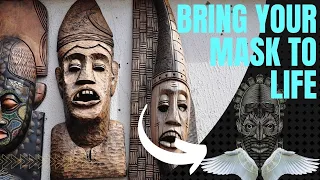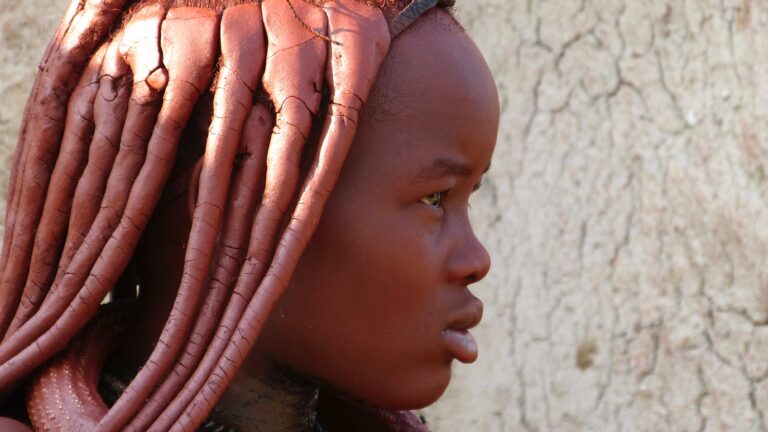African scarification traditions: Meaning, Significance, and Traditions
African scarification traditions, an ancient practice deeply embedded in African history and culture, is far more than a mere physical alteration of the skin. It is a sacred art form, a rite of passage, and a powerful symbol of identity, beauty, and spirituality. Across the continent, various African communities have used scarification for centuries to convey intricate social messages, mark significant life events, and connect individuals to their ancestors and cultural heritage. This article delves into the meaning and significance of scarification, explores its role in specific African cultures, and examines the considerations surrounding this enduring tradition.
Table of Contents
Toggle
What Is Scarification?
Scarification involves intentionally cutting, etching, or branding the skin to create permanent patterns, designs, or scars. Unlike tattoos, which inject ink into the dermis, scarification manipulates the skin’s surface to produce raised or indented marks through controlled healing. In African cultures, these scars are not random; they carry profound meanings tied to identity, status, and cosmology. The tools and techniques vary—some use sharp blades, thorns, or stones, while others employ burning or abrasion—but the outcome is always intentional and symbolic.
The practice predates modern history and has been documented across numerous African tribes, from the Dinka of South Sudan to the Yoruba of Nigeria. According to Smithsonian Magazine, scarification is one of the oldest forms of body modification, with evidence suggesting its presence in Africa for thousands of years. For these communities, the body becomes a canvas, telling stories of lineage, resilience, and belonging.
The Significance of African Scarification Traditions
In African societies, scarification transcends aesthetics. It serves as a visual language, communicating an individual’s place within their community. Here are some of the key roles it plays:
- Identity and Tribal Affiliation: Scars often distinguish one tribe from another. Unique patterns or placements—whether on the face, chest, or abdomen—signal membership in a specific group, fostering a sense of unity and pride.
- Rites of Passage: Scarification frequently marks transitions such as puberty, marriage, or warrior status. The pain endured during the process symbolizes strength and readiness for adult responsibilities.
- Beauty and Adornment: In many cultures, scars enhance physical attractiveness. Smooth, unblemished skin might be seen as plain, while intricate scars elevate one’s appeal.
- Spiritual Protection: Some believe scars ward off evil spirits or connect the individual to ancestral forces, embedding a layer of metaphysical significance.
The video “The Sacred Art of Scarifications Among African Culture” beautifully illustrates these purposes, showcasing individuals adorned with scars that reflect their heritage and personal journeys.
Scarification in Specific African Cultures
To fully appreciate African scarification traditions, let’s explore how they manifest in specific communities, each with its own motivations and methods.
The Dinka of South Sudan
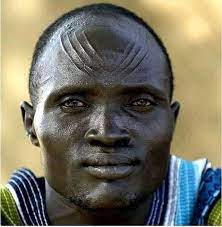
The Dinka, a Nilotic ethnic group, are renowned for their forehead scarification, particularly among men. Young Dinka boys undergo this ritual as a passage into manhood, typically between the ages of 10 and 15. Using a curved blade, elders cut parallel lines across the forehead, creating a V-shaped pattern. The process is agonizing, and crying is forbidden—a testament to the initiate’s courage.
For the Dinka, these scars signify maturity and readiness to protect the community. They also enhance social standing, as scarred men are considered more desirable for marriage. Anthropologist Francis Mading Deng notes that this practice reinforces Dinka identity in a region marked by conflict and displacement, preserving their cultural legacy amid modernization.
The Nuba of Sudan
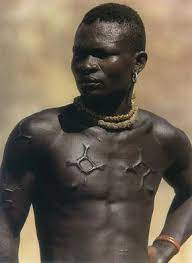
Among the Nuba peoples of Sudan’s Kordofan region, scarification is a celebration of femininity and life stages. Women receive scars at key milestones: puberty, the birth of their first child, and sometimes after subsequent births. The patterns—often radiating across the chest, stomach, or back—are created by lifting the skin with a thorn and cutting it with a blade, resulting in keloid scars that heal into raised designs.
These scars are a badge of honour, symbolizing fertility and resilience. According to National Geographic, Nuba women view scarification as an enhancement of beauty, aligning with cultural ideals that prize textured skin over smoothness. The practice also strengthens communal bonds, as women support each other through the process.
The Yoruba of Nigeria
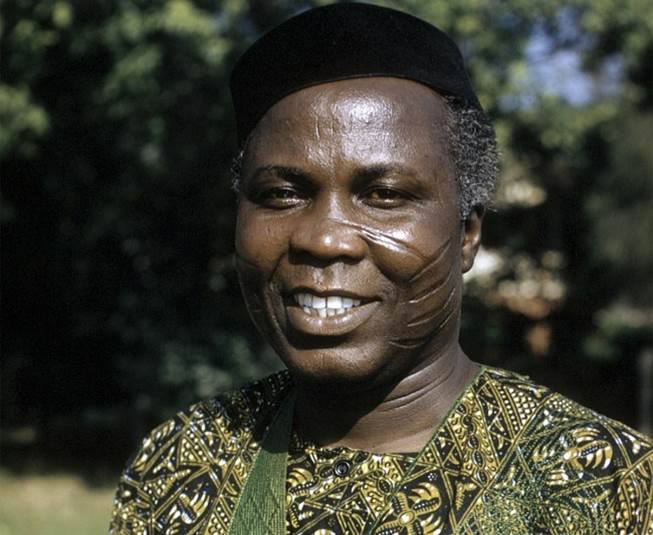
In Yoruba culture, facial scarification, known as ila, historically served as both identification and adornment. Vertical or curved lines were etched onto the cheeks or forehead, often during infancy, to denote family lineage or regional origin. For example, the Oyo subgroup favoured three parallel marks, while the Egba used a different configuration.
Beyond tribal markers, ila carried spiritual weight. The Yoruba believed scars could protect against malevolent forces or ensure a child’s survival in a time of high infant mortality. Though colonial influences and urbanization have diminished its prevalence, remnants of this tradition persist in rural areas, as documented by The British Museum.
The Suri of Ethiopia
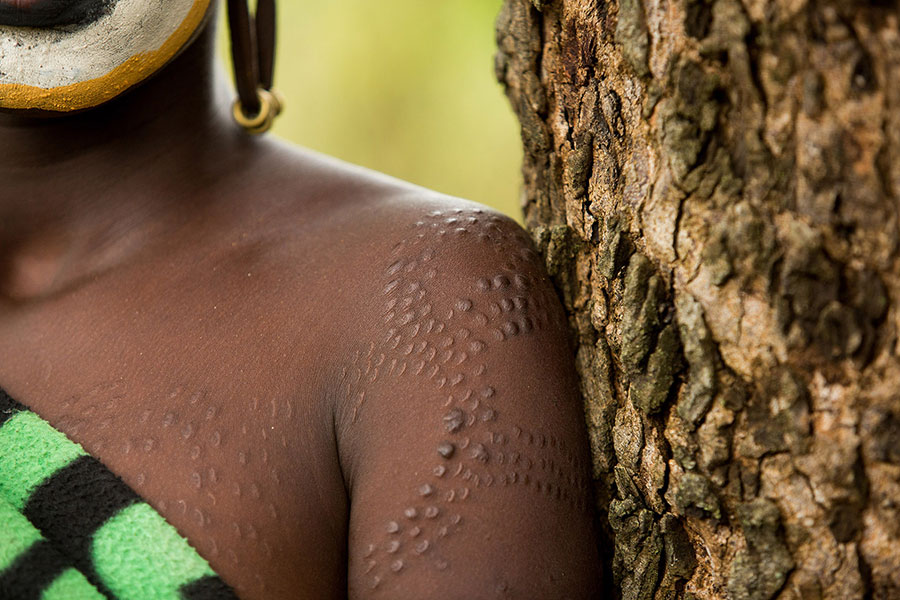
The Suri people of Ethiopia’s Omo Valley practice scarification as an art form and a competitive display of beauty. Young women voluntarily undergo the procedure, often on their arms or torsos, using thorns or knives to create intricate patterns. The scars are seen as a prerequisite for marriage, signaling a woman’s endurance and allure.
Photographer Eric Lafforgue has captured Suri scarification ceremonies, noting that the process is a social event, accompanied by music and communal participation. This reflects the Suri’s emphasis on collective identity and aesthetic expression.
Considerations and Controversies
While African scarification traditions are rich with meaning, they are not without complexity. Several factors warrant consideration:
- Health Risks: Traditional scarification lacks modern sterilization, raising the risk of infection or complications like hepatitis. In some regions, efforts to educate communities about hygiene have led to safer practices, blending tradition with precaution.
- Colonial Legacy: European colonizers often viewed scarification as barbaric, imposing bans or shaming practitioners. This stigma lingers, influencing younger generations to abandon the custom.
- Modernization and Decline: Urbanization and globalization have shifted beauty standards, with many Africans now favoring unscarred skin or tattoos. However, some revivalists argue for its preservation as a cultural treasure.
The Enduring Legacy of African scarification traditions
Scarification remains a testament to Africa’s diverse cultural tapestry. It is a practice steeped in history, resilience, and pride, adapting to contemporary realities while retaining its sacred essence. From the Dinka’s warrior marks to the Nuba’s maternal symbols, these scars narrate stories of survival and belonging that resonate beyond borders.
For those interested in exploring further, resources like The Africa Center and UNESCO’s Intangible Cultural Heritage offer deeper insights into African scarification traditions. The practice invites us to reconsider beauty, identity, and the ways we mark our existence—both on our bodies and in our communities.
In a world of fleeting trends, scarification stands as a permanent reminder of where we come from and who we are. As the video poignantly demonstrates, it is not just an art—it is a legacy etched in skin.


